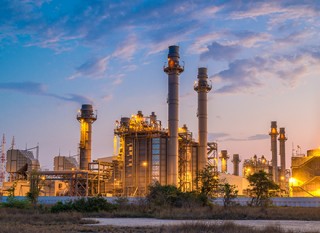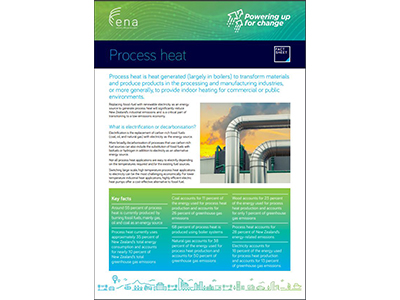Process Heat
21 June 2022
Process heat is heat generated (largely in boilers) to transform materials and produce products in the processing and manufacturing industries, or more generally, to provide indoor heating for commercial or public environments.
Key facts
- Around 55 percent of process heat is currently produced by burning fossil fuels, mainly gas, oil and coal as an energy source
- Process heat currently uses approximately 35 percent of New Zealand’s total energy consumption and accounts for nearly 10 percent of New Zealand’s total greenhouse gas emissions
- Coal accounts for 11 percent of the energy used for process heat production and accounts for 26 percent of greenhouse gas emissions
- 68 percent of process heat is produced using boiler systems
- Natural gas accounts for 38 percent of the energy used for process heat production and accounts for 50 percent of greenhouse gas emissions
- Wood accounts for 23 percent of the energy used for process heat production and accounts for only 1 percent of greenhouse gas emissions
- Process heat accounts for 28 percent of New Zealand’s energy-related emissions
- Electricity accounts for 18 percent of the energy used for process heat production and accounts for 13 percent of greenhouse gas emissions.
Replacing fossil-fuel with renewable electricity as an energy source to generate process heat will significantly reduce New Zealand’s industrial emissions and is a critical part of transitioning to a low-emissions economy.
What is electrification or decarbonisation?
Electrification is the replacement of carbon-rich fossil fuels (coal, oil, and natural gas) with electricity as the energy source.
More broadly, decarbonisation of processes that use carbon-rich fuel sources can also include the substitution of fossil fuels with biofuels or hydrogen in addition to electricity as an alternative energy source.
Not all process heat applications are easy to electrify, depending on the temperatures required and/or the existing fuel sources.
Switching large-scale, high temperature process heat applications to electricity can be the most challenging economically. For lower temperature industrial heat applications, highly efficient electric heat pumps offer a cost-effective alternative to fossil fuel.
Process heat energy consumption by sector
- Almost 80 percent of process heat is used by industry, particularly in processing industries to transform natural materials in the production of final products – for example, using heat to process wood into pulp and paper, milk into milk powder, and the manufacture of aluminium and steel
- The commercial sector uses 10 percent of New Zealand’s process heat, mainly for space heating in large buildings and offices
- The public sector uses 7 percent of process heat – for example, to produce steam in hospitals for heating buildings and sterilisation
- The agricultural sector uses 4 percent – mainly for indoor cropping (i.e. glass houses).
Support for industry to make the change
In the 2022 budget, the government provided $650 million over three years to support industry decarbonise the production of process heat.
What are lines companies doing to prepare?
In some cases, electrifying process heat for industry will require the load carrying capacity for parts of the local electricity distribution networks to be enhanced.
Lines companies are engaging with local users of process heat to ensure there is sufficient existing or future capacity on
their networks to support electrification.
More information
- Decarbonising process heat: Ministry of Business, Innovation & Employment (mbie.govt.nz)
- Process heat – overview
- Phasing out fossil fuels in process heat: national direction on industrial greenhouse gas emissions consultation document
- Demand for coal and Liquid fuel fuel for industrial process heat: A map of New Zealand showing demand for coal and Liquid fuel fuels for industrial process heat by region.



